November 4th, 2019 at 8:49 pm (Animals, Biology)
I was raking up a ton of leaves that had fallen in my yard when I discovered a little ball of brown and black amongst the leaves. I repositioned him in a tree and took a picture:
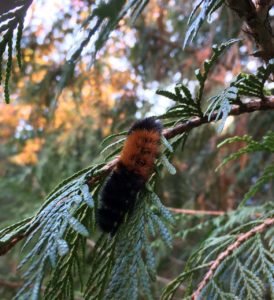
I did some sleuthing and found that this is a wooly bear caterpillar (they roll into a ball when disturbed). They transform into the beautiful Isabella tiger moth.

I marvel anew at how different these forms can be. And then there’s this amazing part of its lifecycle:
The banded woolly bear larva emerges from the egg in the fall and overwinters in its caterpillar form, when it literally freezes solid. First its heart stops beating, then its gut freezes, then its blood, followed by the rest of the body. It survives being frozen by producing a cryoprotectant in its tissues. In the spring it thaws. (Wikipedia)
Wow! I’ll have to look for this guy again in the spring. I hope he makes it :) (But maybe he’ll be a moth by then!)
Comments
July 2nd, 2016 at 10:36 pm (Animals, Biology, Nature)
I recently discovered iNaturalist, which is a website and smartphone app that encourages you to collect observations of plants, animals, and insects. By recording when and where they were observed, you contribute to the store of data about these organisms. This place must be every biologist’s dream come true! Data for free!
They’ve put some thought into how to ensure high quality data. When you log an observation of, say, a ladybug, you can simply record it as “insect” and let others refine it, or be as specific as you feel confident to narrow down its precise species. The crowd of other users will review your tag and vote for it as correct or make corrections. When an organism is pinned down at the species level, that observation becomes “research grade.”
 So far I have contributed observations of a praying mantis (needs review) and a raccoon (research grade!). When you log an observation and connect it with a species, you also get to see a map of where else that species has been seen.
So far I have contributed observations of a praying mantis (needs review) and a raccoon (research grade!). When you log an observation and connect it with a species, you also get to see a map of where else that species has been seen.
You can also “subscribe” to get updates whenever a particular organism of interest is spotted! I signed up for praying mantises (mantis religiosa), spiny lizards (at the genus level (sceloporus), not a species), and collared lizards (family crotaphytidae – a beautiful creature from my childhood). Just today I’ve seen a bunch of new lizard observations (one dead). I’m looking forward to more. (I’m also being exposed to the Latin names for things. What fun!)
Another cool feature is that you can browse an area (say, where you are currently standing) to see what has been observed there.` You can also join specific research “projects” and contribute your matching observations (e.g., a project might specify that they want only pictures of reptiles observed in southern California).
I love to see well constructed efforts to engage people in the process of science. This one seems particularly compelling and enjoyable to use.
Comments
February 8th, 2013 at 2:45 pm (Animals, Books, History, Library School)
In my class on the History of Books and Libraries, we were recently introduced to this fun 9th century Irish poem. My own cat and I are amused.
The cat’s name, Pangur Bán, is a little tricky to decode. “Bán” means “white,” and “Pangur” seems to have been a common name for cats (maybe like Felix) that may mean “Fuller” (as in fulling cloth: beating it to remove dirt and impurities — like how cats knead blankets?).
I and Pangur Bán, my cat
‘Tis a like task we are at;
Hunting mice is his delight
Hunting words I sit all night.
Better far than praise of men
‘Tis to sit with book and pen;
Pangur bears me no ill will,
He too plies his simple skill.
‘Tis a merry thing to see
At our tasks how glad are we,
When at home we sit and find
Entertainment to our mind.
Oftentimes a mouse will stray
In the hero Pangur’s way:
Oftentimes my keen thought set
Takes a meaning in its net.
‘Gainst the wall he sets his eye
Full and fierce and sharp and sly;
‘Gainst the wall of knowledge I
All my little wisdom try.
When a mouse darts from its den,
O how glad is Pangur then!
O what gladness do I prove
When I solve the doubts I love!
So in peace our tasks we ply,
Pangur Bán, my cat, and I;
In our arts we find our bliss,
I have mine and he has his.
Practice every day has made
Pangur perfect in his trade;
I get wisdom day and night
Turning darkness into light.
Translation by Robin Flower
Comments
February 7th, 2013 at 9:46 pm (Animals, Biology)
I killed two ants the other day, for Science. “Adventures with a Microscope” instructs you in how to kill a fly so that you can remove its legs and eyes for a close look under the microscope. No flies were available, so I victimized some ants who kept trying, with mindless persistence, to invade my personal space. I put them under glass, where one asphyxiated, slowly, as I had no chloroform. The other escaped and I flicked it into some water, where it drowned. I felt more than a few twinges of guilt, staring at their huddled corpses, but then decided to examine them under the microscope.
And oh, how glorious!
40x (lowest magnification):
The segmented, slightly blurry object on the right is its antenna.
The thin filament is (I think) carpet fuzz.
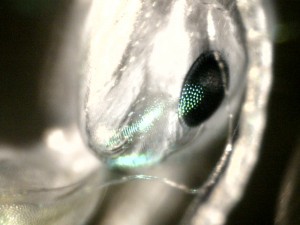
Note the difference in texture between chitin and eye (zoom 100x):
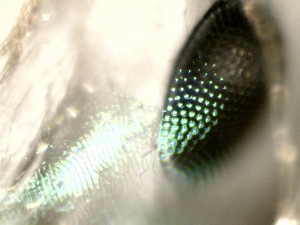
Zoom 200x:
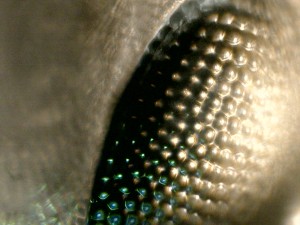
These were all taken with reflected light, since ants don’t transmit light well. But are they not beautiful and alien, seen up so close? We’ve all heard of the fly’s multi-faceted eye. I’m not sure I realized that the ant’s is likewise complex and compound.
Wow.
7 Comments
4 of 5 people learned something from this entry.
April 6th, 2012 at 7:39 pm (Animals, Food, History)
Yeah, I blinked at the headline, too. One of my projects at the Monrovia Library is scanning old newspapers (on microfilm) into digital files for easy later access (and hopefully indexing). This item came from the July 2, 1915 issue of the Monrovia Messenger:
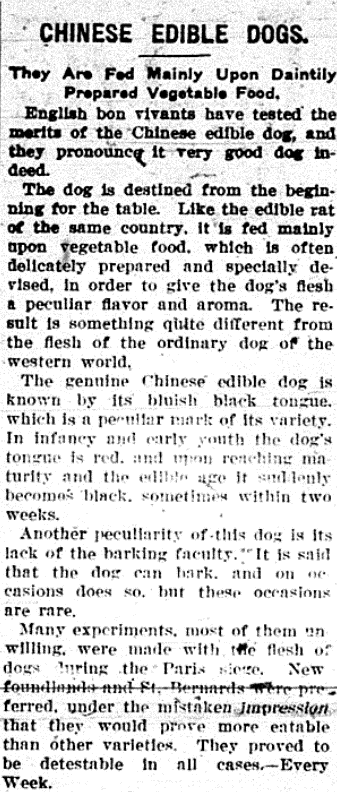
Interesting slice of history!
2 Comments
2 of 2 people learned something from this entry.






